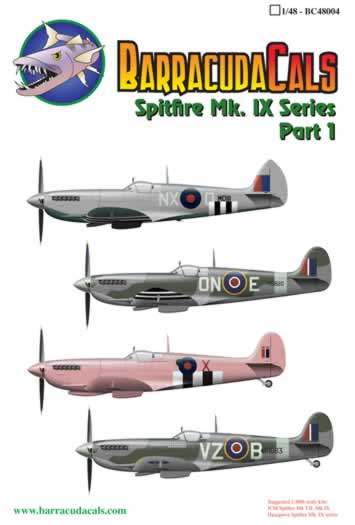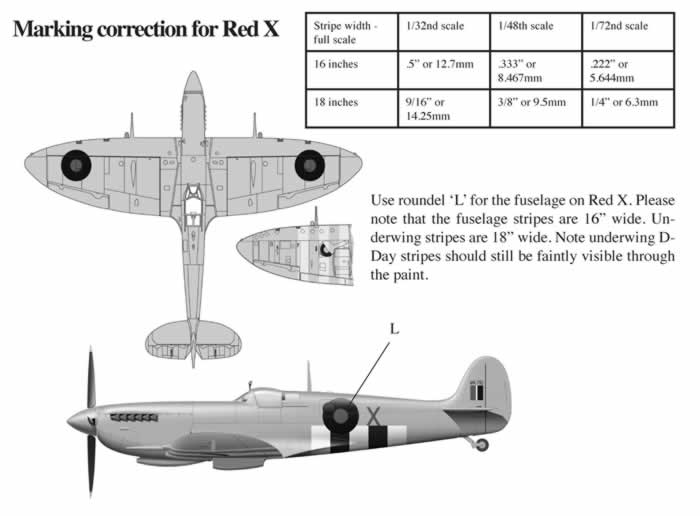Spitfire Mk.IX Series
Part 1

BarracudaCals, 1/48 scale
Summary |
Catalogue Number: |
BarracudaCals BC48004 - Spitfire Mk.IX Series Part 1 |
Scale: |
available in 1/72, 1/48 and 1/32 scales |
Contents and Media: |
Decal sheet, full colour instruction sheet in a resealable bag. |
Price: |
1/72 scale USD $9.95
1/48 scale
USD $9.95
1/32 scale USD $13.95
available online from BARRACUDAcals website
also available online from Hannants and Sprue Brothers |
Review Type: |
FirstLook |
Advantages: |
Informative instruction sheet, decals in perfect register, varied subject matter, thin carrier film and a compliment of stencil data. |
Disadvantages: |
|
Conclusion: |
A well produced decal sheet that contains an interesting assortment of subjects to suit a variety of tastes. |
Reviewed by Rob Baumgartner

HyperScale is proudly supported by Squadron.com
Spitfires have always been a favourite subject amongst aircraft modelers so this new release is bound to please.
There are 4 subjects on this sheet, each offering a colour scheme sufficiently different from the rest.
The recommended kits are the ICM Spitfire Mk.VII, Mk IX and the Hasegawa Spitfire Mk. IX series.
- Spitfire HF. VII, serial number MD111, 131 Squadron, RAF, pilot unknown.
This aircraft was based at Culmhead, Somerset, England, in early August, 1944. In helping the daylight raids of Bomber Command it wore the Medium Sea Grey upper surfaces and PRU Blue lower surfaces of high altitude fighters.
The D-Day stripes around the fuselage and on the outer wings were non standard in that they were 9” wide. If you wish to model MD111 as it appeared in mid-July, simply extend the bands to go all the way around the fuselage.
- Spitfire HF.VII, serial number MB820, 124 Squadron, RAF, flown by Flying Officer Barrit.
Based at Northolt, Greater London, England in September 1943 it is seen in the markings of Operation Starkey. This Operation was to mislead the Germans with a feigned invasion.
Upper surfaces were in Ocean-Grey and Dark Green with Medium Sea Grey undersurfaces. It shared in a victory on September 9th when it intercepted an Fw 190. The 18” bands were on the wings only with the spinner and fuselage band being in Sky.
- Spitfire FR. IX, serial number MK716, 16 Squadron, RAF, pilot unknown.
Finished overall in PRU pink for dawn and dusk operations, this aircraft was seen based at Balleroy (A.12), France, September 1944.
Once again, to represent the aircraft in its July 1944 state, the modeller can wrap the D-Day bands completely around the fuselage. The machine is seen with a single oblique camera port, covered main wheels and an Aero Vee carb intake.
- Spitfire Mk. IXc, serial number MH883, 412 Squadron RCAF, 126 Wing, 2nd TAF.
Based at Biggin Hill, England in January 1944, this aircraft was flown by Flight Lieutenant George “Buzz” Beurling.
With 31 victories, he became the highest scoring Canadian Ace in WWII. The camouflage on this machine consisted of the usual Ocean Grey and Dark Green uppersurfaces over Medium Sea Grey undersurfaces.
As before we have the Aero Vee carb intake fitted and the aircraft carries a Sky spinner and fuselage band.
All of the above information (and more) is generously laid out in the instruction sheet.

The items were in perfect register and the thin carrier film was kept to a minimum around each object. The inclusion of stencil data is always welcome and the instruction sheet gives an indication where everything should go.
This is an excellent release with something to please everyone.
Thanks to BarracudaCals for the samples
BarracudaCals decals are
available online from their website
Text and Images Copyright © 2009 by Rob Baumgartner
This Page Created on 4 January, 2009
Last updated
11 June, 2009
Back to
HyperScale Main Page |
